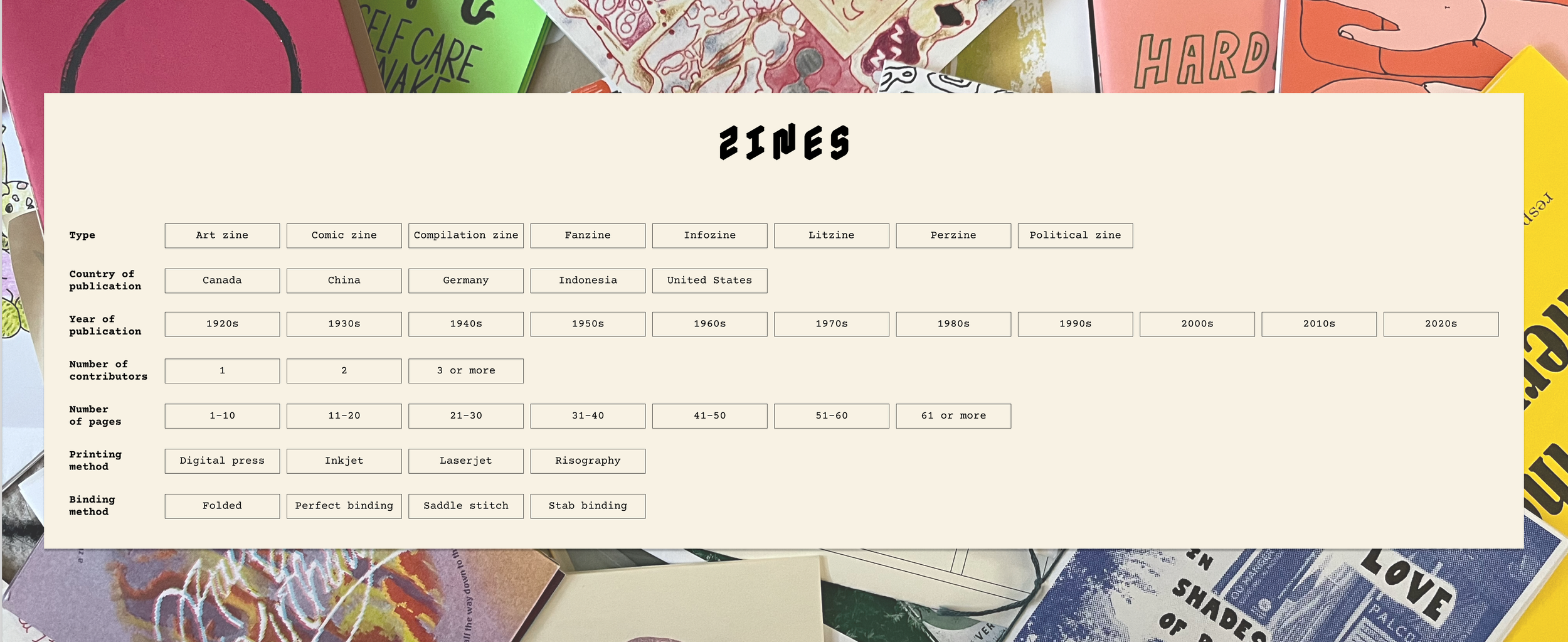Classification System - Create
Learning opportunity
For this assignment, we were tasked with creating a faceted classification system to organize a set of resources of our choice. Faceted classification systems are designed to group items into mutually exclusive categories at varying levels of specificity. The classification system needed to include at least 4 facets and at least 12 isolates.
Context and use case
I chose to organize a portion of my personal zine collection for this faceted classification system. A zine can be defined as a self-published publication, usually created and distributed outside of mainstream publishing methods, about a variety of topics and interests. This classification system was designed to organize 80 zines for my personal use. The facets/categories were chosen based on my interest in key attributes about zines in my collection that I would like to use when conducting a search and contextualizing each zine in the broader collection.
First attempt
Examples
The following are examples of items in my zine collection classified with the facets from my system:
Let’s by Mata
Perzine, Germany, 2020s, 1, 1-10, Laserjet, Folded
Public Illumination Magazine Issue No. 34: Foreigners
Compilation zine, United States, 1980s, 3 or more, 21-30, Offset, Saddle stitch
31 Dec 2020 23:61 by Glary Wu & Hannah Shieh
Artzine, China, 2020s, 2, 21-30, Risography, Saddle stitch
Index of Ranganathan’s Fundamental Categories (1945)
Below is an index for how the facets in my classification system align with Ranganthan’s fundamental categories as set out in his Colon Classification system:
Personality - Type, Number of authors
Matter - Printing method, Binding method
Energy - N/A
Space - Country of publication, Number of pages
Time - Year of publication, Number of pages
Peer review feedback
In the feedback I received from my peers about my classification system, these were the key points:
System was easy to understand, visually appealing, and well-suited to the sample of zines
Order of facets indicates the importance of each category (e.g. zine type is more important than number of pages)
“Type of zine” was a facet that had potential issues with mutual exclusivity and as a fundamental category (i.e. A zine could be unfit for any of the listed zine types or there could be overlap between zine types)
“Number of pages” could include an additional facet that is “61+”
“Year of publication” could include years prior to 1980s given that zines date back to the 1920s; it is easier to add more recent years versus adding past years
Revised attempt
Index of Ranganathan’s Fundamental Categories (1945) - Revised
Below is an index for how the facets in my classification system align with Ranganthan’s fundamental categories as set out in his Colon Classification system:
Personality - Type, Number of authors
Matter - Printing method, Binding method
Energy - Printing method
Space - Country of publication
Time - Year of publication
Reflection
The process of creating this classification system took more time and effort than I initially expected. I realized that in order to determine facets that would appropriately capture the set of zines I had chosen to organize, it would require examining and recording the attributes of each zine before creating more generalized categories. I struggled to map each of the facets in my classification system to Ranganthan’s Fundamental PMEST categories, but with instructor feedback, I was able to generate a revised index. Overall, this process gave me a better understanding of faceted classification systems and the categorization of things with aboutness.
After some self-reflection, I decided to change the facet “Number of authors” to “Number of contributors” since I felt this better reflected the zine-making process. By applying the peer review feedback I received, I was able to revise my faceted classification system to more adequately categorize any additions to the collection, such as a zine that was published before the 1980s. While zine type was identified as a facet that would present challenges in my system, I decided not to revise this category because I realized that faceted classification may not be the most appropriate system for organizing information about zine types. Given the hybridity of zine types and genres, it is challenging to achieve mutual exclusivity of isolates for this particular facet. In this particular case, I am operating on the assumption that compromises need to be made for zines that overlap in type. When classifying said zines, one needs to choose the type it is “most like”. Ideally, the contributor of each zine would self-select which type their zine belongs to.




